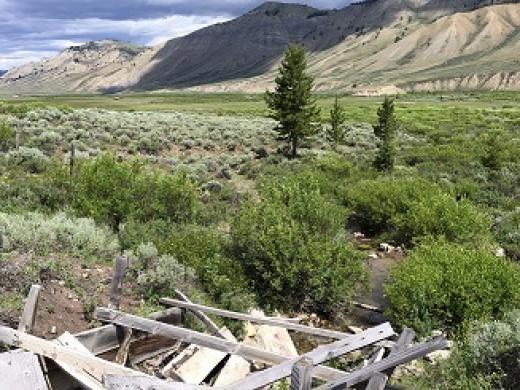PARTNERSHIP LED BY TU AND TPL TO RECONNECT TRIBUTARIES IN THE GROS VENTRE HEADWATERS
Tuesday, September 26th, 2017
Contacts:
Leslie Steen, Snake River Headwaters Project Manager, Trout Unlimited, 307-699-1022, lsteen@tu.org
Chris Deming, Senior Project Manager, Trust for Public Land, 307-739-3941, chris.deming@tpl.org
PARTNERSHIP LED BY TROUT UNLIMITED AND TRUST FOR PUBLIC LAND TO RECONNECT TRIBUTARIES IN THE GROS VENTRE HEADWATERS
JACKSON, Wyoming – Trout Unlimited (TU) and the Trust for Public Land (TPL) announced today the implementation of the Upper Gros Ventre River Ranch (UGVRR) Tributary Restoration Project has started and will continue through mid-October. The project is a partnership to reconnect and restore four tributary streams in the headwaters of the Gros Ventre River for native Snake River cutthroat trout and other riparian-dependent species. Through the project’s activities, 15.5 miles of stream will once again connect to the Gros Ventre River, providing coldwater inputs to the mainstem river and more than 5 miles of habitat for native cutthroat trout.
The UGVRR project area is located deep in the headwaters of the Gros Ventre River, approximately 25 miles upstream from lower Slide Lake and 31 miles ESE of the town of Kelly, Wyoming. The project builds on the success of a land protection project initiated in 2015 in which former Senator Herb Kohl donated the 990-acre UGVRR to TPL for future transfer to the Bridger-Teton National Forest (BTNF), with support from the Jackson Hole Land Trust. Prior to the land becoming public as part of the BTNF later this year, project partners sought to restore historic impairments to the tributaries on the property.
“Thanks to the generosity of Herb Kohl and the support of our partners and donors, the Upper Gros Ventre River Ranch will be both preserved and enhanced prior to conveyance to the Bridger-Teton National Forest. The partnership with Trout Unlimited for the restoration of these critical headwater tributaries is a wonderful example of their work in the Upper Snake River watershed and a great outcome for this blue ribbon fishery,” said Chris Deming, Trust for Public Land Senior Project Manager.
There are four impaired tributary streams within the UGVRR project area with either limited connectivity or none at all with the Gros Ventre River – Jones, Lafferty, Lloyd, and Unnamed creeks. The source of the impairment is a large, property-spanning irrigation ditch system, known as the Common Sense Ditch, which was used to withdraw water from the mainstem river and subsequently crossed each tributary, diverting their flow for irrigation. Although the land has not been irrigated since the 1970s, the abandoned irrigation system has not yet been reclaimed, and, in some areas, the historic stream channel has been completely lost through conversion into hay meadows.
Historically, these streams would have provided nursery habitat for juvenile Snake River cutthroat trout (Wyoming Game and Fish Department Species of Greatest Conservation Need) and associated stream and riparian habitat for wildlife, including crucial winter habitat for moose. Although Lafferty Creek had fish present in 1998, sampling by WGFD in 2016 and 2017 documented no fish in any of the project area streams.
“Streams of similar size in the upper Gros Ventre are known to support small trout, and the cold water, habitat diversity, and refuge they provide are important to the health of the fishery as a whole,” said Rob Gipson, Regional Fisheries Supervisor, WGFD.
The UGVRR project will address these impairments by restoring high-functioning, natural conditions within the four tributary streams by removing irrigation structures and plugging old lateral ditches to restore tributary flows, recreating sections of stream where the historic channel has been lost, restoring degraded habitat, and replacing undersized culverts at road crossings with ones that can withstand a 100-year flood event. Road crossings on two additional tributary streams, Little Cow Creek and Unnamed Creek 2, will also be improved.
“This is a very unique opportunity to turn back time on this landscape, so that after more than 100 years, these four tributary streams will once again connect to the Gros Ventre River to provide cold, clean water and native trout habitat,” said Leslie Steen, TU Snake River Headwaters Project Manager. “We are grateful to the many partners and donors that share our vision for the project and have provided financial and technical support to make it happen.”
The project’s cumulative system benefits include native cutthroat trout spawning and rearing habitat in the stream segments, seasonal thermal refuge in the mainstem river, riparian habitat for a diversity of wildlife species, and natural stream flow dynamics. The restoration of these high quality ecological conditions will provide benefit to the public that will be able to access and enjoy the land in perpetuity following transfer of the land to the Bridger-Teton National Forest.
“I am extremely thankful for the leadership and efforts of Trout Unlimited and the Trust for Public Land to restore hydrologic connectivity to the Gros Ventre River even before the lands are brought into the National Forest System. The lands being restored have been important to the settlement and history of the Gros Ventre, and now we have the opportunity to return them to productive wildlands,” said Dale Deiter, Jackson District Ranger for the Bridger-Teton National Forest.
The Upper Gros Ventre River Ranch Tributary Restoration Project was funded by the Community Foundation of Jackson Hole, Jackson Hole One Fly Foundation, Jackson Hole Trout Unlimited, Teton Conservation District, US Fish and Wildlife Service, US Forest Service, Wyoming Game and Fish Department Habitat Trust Fund, Wyoming Wildlife and Natural Resources Trust, and individual donations.
The Upper Gros Ventre River Ranch Tributary Restoration Project is a project of TU’s Snake River Headwaters Home Rivers Initiative, an ambitious initiative to restore and protect the headwaters of the upper Snake River and its fishery, together with a diverse group of community, landowner, and agency partners.
Visit TU’s Snake River Headwaters Initiative microsite for more information and photos.


